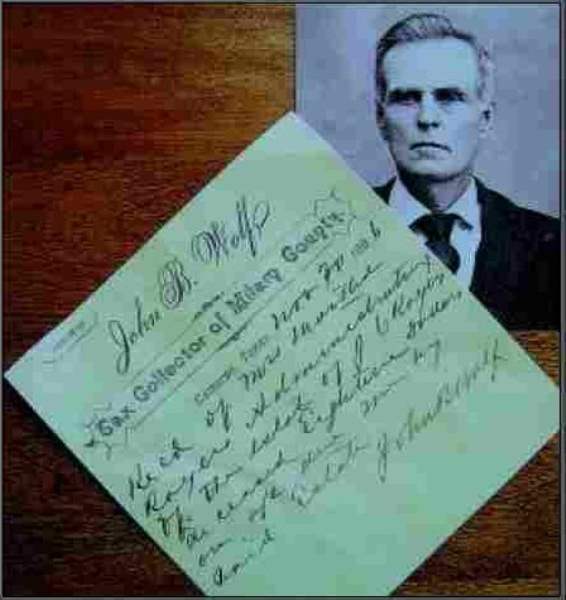Milam County Historical Commission
Milam County, Texas
Milam County, Texas






Confederate hero was Milam history maker
By Jeanne Williams
Temple Daily Telegram - 2011-01-31
CAMERON — John B. Wolf made Milam County history as the last person to officiate in
the combined offices of sheriff and tax collector, and the first to become the county’s
designated tax collector.
But American history remembers Wolf for his involvement in a famous Civil War episode
chronicled by newspapers as The Maple Leaf Incident — a victory for the Confederates,
and an embarrassing defeat to the Union Army.
Wolf mustered into the Confederate Army as a private, and was commissioned captain of
Company I, 14th Arkansas Infantry in 1862. Though never wounded, Wolf’s capture and
escape made head lines.
On the capture of Port Hudson, La., in June 1863, federal authorities paroled privates,
but retained commissioned officers, including Wolf, with the intention of imprisoning
them.
One of Wolf’s fellow escapees was Capt. Joseph H. Long, a former Milam County deputy
sheriff who enlisted in Capt. Charles Buckholts’ 4th Regiment Texas Mounted
Volunteers, and who served in Sibley’s Brigade in the Battle of Glorieta in New Mexico.
Long, captured in the Battle of Port Hudson, “was one of the prisoners of war, who on
June 10, 1863, while being transported ...rose on the guard, overpowered it and made
their escape.”
Long survived the war and returned to Milam County.
“We were put aboard a gunboat at Port Hudson and sent down to New Orleans, where we
were transferred to the steamer Catawba guarded by Billy Wilson’s New York Zouaves and
taken to Fortress Monroe,” Wolf stated in a narrative for the book “History of Texas.”
At that point the prisoners were transferred to another steamer called The Maple Leaf
manned by a captain and crew of 15 sailors, plus federal soldiers commanded by a
lieutenant. The intention was to transport the Confederate officers to Johnson’s Island
near New York City, Wolf said.
“We had no desire to go to prison and we were not long in making up our minds to affect
an escape if such a thing were possible,” Wolf said. The 75 Confederate officers began
plotting an escape, though they recognized the advantage of armed federals guarding
them.
“But the Confederates, being officers and, as you might say in a certain sense picked
men, were not lacking in brains, resource and courage,” Wolf said.
The Confederates waited quietly for the opportunity to take over. Once the ship was out
to sea, the federals relaxed their vigilance “trusting, I reckon to the waters and to
our supposed submission to fate.”
At 10 a.m., the Confederate prisoners rushed the guards and crew, took over the ship,
and headed for the shore. About sundown, the ship secured a safe landing off Cape Henry
in Princess Ann County, Va. The escapees paroled federal guards and crew and left
behind about 10 of their sick or wounded on board. The rest set out on foot for
Richmond.
“We were then, although we did not know it, in Union lines, but we soon began to
encounter obstacles and these multiplied as we proceeded until it became expedient for
us to seek safety in the swamps of North Carolina,” Wolf said. “We were concealed in
those swamps some 10 to 12 days, being fed and protected by the families of Confederate
soldiers who were then at the front and kept informed by them the movements of the
enemy. “
An old guerrilla captain named W. B. Sandlin and a company of boys secured small boats
and transported the escaped prisoners into Confederate territory, where they set out
toward Richmond. Enroute, they were met by a detachment of Gen. D.H. Hill’s Cavalry,
which had been sent by Confederate President Jefferson Davis to assist the escapees.
The Maple Leaf incident reported in northern newspapers had been channeled to
authorities at Richmond.
“We received a royal welcome at the seat of the Confederate government, and what we
needed and appreciated fully as much, rest and food. For my part I remained there only
a few days when I started west to rejoin my command,” Wolf said.
Wolf received an honorable discharge at Marshall in May 1865.
From 1865 to 1869, Wolf resided in Arkansas and farmed. In 1866 he married Agnes Adams
of Marion County, Ark. They moved to Milam County in 1869, where Wolf farmed and
operated a mercantile business in Davilla and Rockdale.
He was elected sheriff/tax collector in 1878, and held the dual office for two years.
When the offices of sheriff and tax collector were separated, Wolf was elected Milam
County’s first tax collector in 1880 and served until 1904.
Accounts provided by the Milam County Historical Museum described Wolf as “one of the
most efficient officers the county has ever had. No man could have held as important an
office as that of collector as long as he has without giving satisfaction in an eminent
degree.”
jwilliams@tdtnews.com
All articles from the Temple Daily Telegram are published with the permission of the
Temple Daily Telegram.
All credit for this article goes to
Jeanne Williams and the Temple Daily Telegram
Temple Daily Telegram.
All credit for this article goes to
Jeanne Williams and the Temple Daily Telegram

Photo by Shirley Williams
.
.
Tax time in 1866. Among Milam County Historical Museum artifacts is a hand-written tax receipt for $18.00 signed by Tax Collector John B. Wolf. The taxes were paid on the estate of former Milam County Judge J. C. Rogers.
The photo is of Wolf.
The photo is of Wolf.